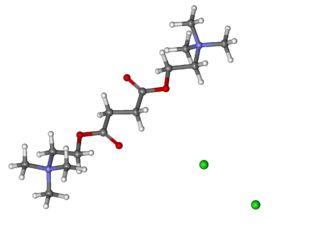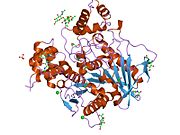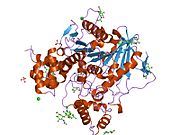
Suxamethonium chloride, also known as suxamethonium or succinylcholine, or simply sux in medical abbreviation, is a medication used to cause short-term paralysis as part of general anesthesia. This is done to help with tracheal intubation or electroconvulsive therapy. It is administered by injection, either into a vein or into a muscle. When used in a vein, onset of action is generally within one minute and effects last for up to 10 minutes.

Procaine is a local anesthetic drug of the amino ester group. It is most commonly used in dental procedures to numb the area around a tooth and is also used to reduce the pain of intramuscular injection of penicillin. Owing to the ubiquity of the trade name Novocain or Novocaine, in some regions, procaine is referred to generically as novocaine. It acts mainly as a sodium channel blocker. Today, it is used therapeutically in some countries due to its sympatholytic, anti-inflammatory, perfusion-enhancing, and mood-enhancing effects.

The enzyme cholinesterase (EC 3.1.1.8, choline esterase; systematic name acylcholine acylhydrolase) catalyses the hydrolysis of choline-based esters:
Butyrylcholine is a choline-based ester that can function as a neurotransmitter. It is similar to acetylcholine, with activation of some of the same receptors as acetylcholine. Butyrylcholine is a synthetic compound and does not occur in the body naturally. It is used as a clinical laboratory tool to distinguish between the cholinesterases; acetylcholinesterase and butyrylcholinesterase preferentially lyse acetylcholine and butyrylcholine, respectively. It is also known as pseudocholinesterase [correction needed].
Pseudocholinesterase deficiency is an autosomal recessive inherited blood plasma enzyme abnormality in which the body's production of butyrylcholinesterase is impaired. People who have this abnormality may be sensitive to certain anesthetic drugs, including the muscle relaxants succinylcholine and mivacurium as well as other ester local anesthetics.

Neuromuscular-blocking drugs, or Neuromuscular blocking agents (NMBAs), block transmission at the neuromuscular junction, causing paralysis of the affected skeletal muscles. This is accomplished via their action on the post-synaptic acetylcholine (Nm) receptors.

Mivacurium chloride is a short-duration non-depolarizing neuromuscular-blocking drug or skeletal muscle relaxant in the category of non-depolarizing neuromuscular-blocking drugs, used adjunctively in anesthesia to facilitate endotracheal intubation and to provide skeletal muscle relaxation during surgery or mechanical ventilation.

Bambuterol (INN) is a long-acting β adrenoceptor agonist (LABA) used in the treatment of asthma; it also is a prodrug of terbutaline. Commercially, the AstraZeneca pharmaceutical company produces and markets bambuterol as Bambec and Oxeol.

Tricresyl phosphate (TCP), is a mixture of three isomeric organophosphate compounds most notably used as a flame retardant. Other uses include as a plasticizer in manufacturing for lacquers and varnishes and vinyl plastics and as an antiwear additive in lubricants. Pure tricresyl phosphate is a colourless, viscous liquid, although commercial samples are typically yellow. It is virtually insoluble in water, but easily soluble in organic solvents like toluene, hexane, and diethylether among others. It was synthesized by Alexander Williamson in 1854 upon reacting phosphorus pentachloride with cresol, though today's manufacturers can prepare TCP by mixing cresol with phosphorus oxychloride or phosphoric acid as well. TCP, especially the all-ortho isomer, is the causative agent in a number of acute poisonings. Its chronic toxicity is also of concern. The ortho-isomer is rarely used on its own outside of laboratory studies that require isomeric purity, due to its extremely toxic nature, and is generally excluded from commercial products where TCP is involved.

Organophosphate poisoning is poisoning due to organophosphates (OPs). Organophosphates are used as insecticides, medications, and nerve agents. Symptoms include increased saliva and tear production, diarrhea, vomiting, small pupils, sweating, muscle tremors, and confusion. While onset of symptoms is often within minutes to hours, some symptoms can take weeks to appear. Symptoms can last for days to weeks.

Acetylcholinesterase (HGNC symbol ACHE; EC 3.1.1.7; systematic name acetylcholine acetylhydrolase), also known as AChE, AChase or acetylhydrolase, is the primary cholinesterase in the body. It is an enzyme that catalyzes the breakdown of acetylcholine and some other choline esters that function as neurotransmitters:

Carboxylesterase, type B is a family of evolutionarily related proteins that belongs to the superfamily of proteins with the Alpha/beta hydrolase fold.

Acetylcholinesterase collagenic tail peptide also known as AChE Q subunit, acetylcholinesterase-associated collagen, or ColQ is the collagen-tail subunit of acetylcholinesterase found in the neuromuscular junction. In humans it is encoded by the COLQ gene.

Acetylcholinesterase inhibitors (AChEIs) also often called cholinesterase inhibitors, inhibit the enzyme acetylcholinesterase from breaking down the neurotransmitter acetylcholine into choline and acetate, thereby increasing both the level and duration of action of acetylcholine in the central nervous system, autonomic ganglia and neuromuscular junctions, which are rich in acetylcholine receptors. Acetylcholinesterase inhibitors are one of two types of cholinesterase inhibitors; the other being butyryl-cholinesterase inhibitors. Acetylcholinesterase is the primary member of the cholinesterase enzyme family.

Cholinesterase inhibitors (ChEIs), also known as anti-cholinesterase, are chemicals that prevent the breakdown of the neurotransmitter acetylcholine or butyrylcholine. This increases the amount of the acetylcholine or butyrylcholine in the synaptic cleft that can bind to muscarinic receptors, nicotinic receptors and others. This group of inhibitors is divided into two subgroups, acetylcholinesterase inhibitors (AChEIs) and butyrylcholinesterase inhibitors (BChEIs).
Dibucaine, also known as cinchocaine, is an amino amide local anesthetic. When administered to humans intravenously, it is capable of inhibiting the plasma cholinesterase (butyrylcholinesterase) enzyme. The dibucaine number is used to differentiate individuals who have substitution mutations of the enzyme's gene, resulting in decreased enzyme function.

Rivastigmine is a cholinesterase inhibitor used for the treatment of mild to moderate Alzheimer's disease. The drug can be administered orally or via a transdermal patch; the latter form reduces the prevalence of side effects, which typically include nausea and vomiting.

Cymserine is a drug related to physostigmine, which acts as a reversible cholinesterase inhibitor, with moderate selectivity (15×) for the plasma cholinesterase enzyme butyrylcholinesterase, and relatively weaker inhibition of the better-known acetylcholinesterase enzyme. This gives it a much more specific profile of effects that may be useful for treating Alzheimer's disease without producing side effects such as tremors, lacrimation, and salivation that are seen with the older nonselective cholinesterase inhibitors currently used for this application, such as donepezil. A number of cymserine derivatives have been developed with much greater selectivity for butyrylcholinesterase, and both cymserine and several of its analogues have been tested in animals, and found to increase brain acetylcholine levels and produce nootropic effects, as well as reducing levels of amyloid precursor protein and amyloid beta, which are commonly used biomarkers for the development of Alzheimer's disease.

Postoperative residual curarization (PORC) or residual neuromuscular blockade (RNMB) is a residual paresis after emergence from general anesthesia that may occur with the use of neuromuscular-blocking drugs. Today residual neuromuscular blockade is defined as a train of four ratio of less than 0.9 when measuring the response to ulnar nerve stimulation at the adductor pollicis muscle using mechanomyography or electromyography. A meta-analysis reported that the incidence of residual neuromuscular paralysis was 41% in patients receiving intermediate neuromuscular blocking agents during anaesthesia. It is possible that > 100,000 patients annually in the USA alone, are at risk of adverse events associated with undetected residual neuromuscular blockade. Neuromuscular function monitoring and the use of the appropriate dosage of sugammadex to reverse blockade produced by rocuronium can reduce the incidence of postoperative residual curarization. In this study, with usual care group receiving reversal with neostigmine resulted in a residual blockade rate of 43%.

Neuromuscular drugs are chemical agents that are used to alter the transmission of nerve impulses to muscles, causing effects such as temporary paralysis of targeted skeletal muscles. Most neuromuscular drugs are available as quaternary ammonium compounds which are derived from acetylcholine (ACh). This allows neuromuscular drugs to act on multiple sites at neuromuscular junctions, mainly as antagonists or agonists of post-junctional nicotinic receptors. Neuromuscular drugs are classified into four main groups, depolarizing neuromuscular blockers, non-depolarizing neuromuscular blockers, acetylcholinesterase inhibitors, and butyrylcholinesterase inhibitors.































